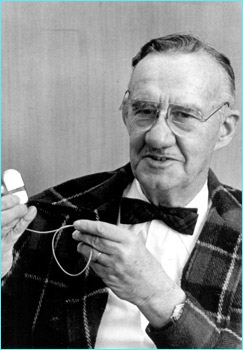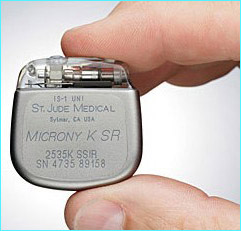

Man suffering from Heart Disease

WIlson Greatbatch

Pacemaker
Wilson Greatbatch
Heart disease is the most common cause of death not only in the United States alone, but also around the world. There is no cure to heart diseases, once you have it, you will live your whole life knowing that you may get a heart attack or a stroke any time. But one invention is about to change how people look at heart disease.
As a child, now Dr. Wilson Greatbatch was always curious about how things worked. He enjoyed playing with rubber band guns as a little kid. His interests developed a little more as he got older. He played with more complicated things, such as his father’s Model T Ford truck. He took it apart, and experimented with the magnets from the car. He then built his own radio and got his amateur radio operator or better known as ham radio’s license at age sixteen. Electricity fascinated him because there are some things that you can’t see with the naked eye but can crucially affect you. Dr. Greatbatch then had a family with three children, which was a great number in his time. His salary was only able to feed half his family. He realized that something had to be done.
Dr. Greatbatch went through many things before achieving where he is now. He first served in the Navy and became a radio operator and a gunner. It was also being in the Navy which helped him earn a degree in Electrical Engineering from Cornell University in 1950. He then felt that he needed more education so he went ahead and got a Master’s Degree in the University of Buffalo in 1957.
A year after that, he invented the pacemaker, quite accidental actually. In 1958, transistors became wildly available. He then quit his job with his savings of two thousand dollars, about enough to feed his family for two years, and started researching. He was constructing an oscillator with one transistor to record the patient’s heartbeat when he suddenly used the wrong transistor which produced a pulse, similar to the rhythm that the human heart has. He quickly worked on a prototype for a pacemaker and built fifty pacemakers and used them in forty animals and ten human patients. He was surprised on how well it worked. At first, he used mercury batteries on the pacemaker and then in the early seventies, Lithium-ion batteries were introduced and giving the pacemaker a lifespan of five to ten years. Dr. Greatbatch’s pacemaker has been saving lives ever since.
The pacemaker has revolutionized the field of medical science as soon as it was inv-ented. As of now, around three million people worldwide have pacemakers and each year, another six hundred thousand are added to the population. Although it is commonly implanted in patients sixty or older, even small children may need a pacemaker from time to time. Not only Dr. Greatbatch contributed to the scientific community, it was also because of him and his labor which led to saving millions of life not only in the United States, but throughout the whole world.
In conclusion, Dr. Wilson Greatbatch’s invention will continue to save lives for generations to come. It will change the views of those who are affected by heart diseases. Dr. Greatbatch’s invention is not a cure for heart disease, but it gives hope to those who are suffering from it.
Bibliography
"Innovative Lives". http://invention.smithsonian.org/centerpieces/ilives/lecture09.html, February 18, 2009.
"Meet the Scientist: Dr. Wilson Greatbatch". http://chapters.marssociety.org/youth/mc/issue6/mts.php3, March 2, 2009.
"Wilson Greatbatch". http://web.mit.edu/invent/a-winners/a-greatbatch.html, March 9, 2009.